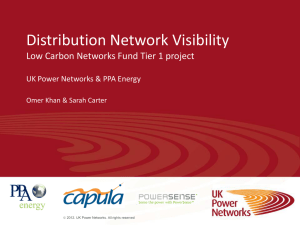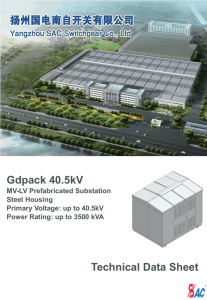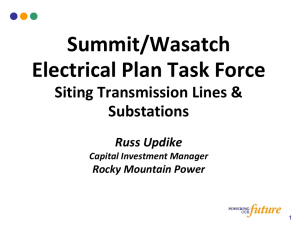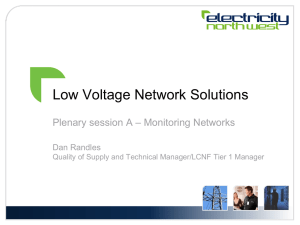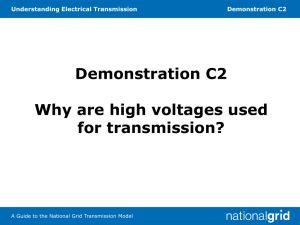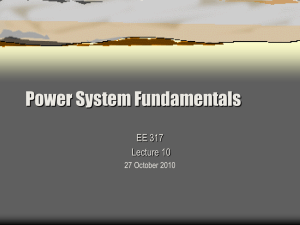Transmission System
advertisement
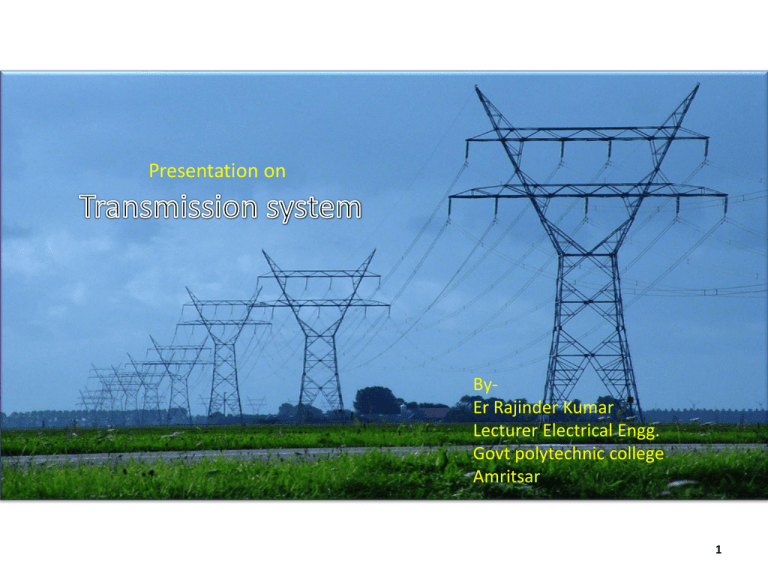
Presentation on ByEr Rajinder Kumar Lecturer Electrical Engg. Govt polytechnic college Amritsar 1 viewers ,After electricity is produced at power plants it has to get to the customers that use the electricity. Our cities, towns, states and the entire country are criss-crossed with power lines that "carry" the electricity. As large generators spin, they produce electricity with a voltage of about 11,000 volts. 2 3 The electricity first goes to a transformer at the power plant that boosts the voltage up to 400,000 volts. When electricity travels long distances it is better to have it at higher voltages. Another way of saying this is that electricity can be transferred more efficiently at high voltages. 4 The long thick cables of transmission lines are made of copper or aluminum because they have a low resistance. We know that the higher the resistance of a wire, the warmer it gets. So, some of the electrical energy is lost because it is changed into heat energy. High voltage transmission lines carry electricity long distances to a substation. 5 Electrical power is generated at different generating stations. These generating stations are not necessarily situated at the load center. During construction of generating station number of factors to be considered from economical point of view. These all factors may not be easily available at load center, hence generating station are not normally situated far away from load center. 6 Fundamentally there are two systems by which electrical energy can be transmitted (1) High Voltage DC Electrical Transmission System (2) High voltage AC Electrical Transmission System There are some advantages in using DC transmission system ,in India we are using High voltage AC Electrical Transmission System . 7 Only two conductor are required for Dc transmission system. It is further possible to use only one conductor of DC transmission system if earth is utilized as return path of the system ii) The potential stress on the insulator of DC transmission system is about 70% of same voltage AC transmission system. Hence less insulation cost is involved in DC transmission system. iii)Inductance,capacitance,phase displacement and surge problems can be eliminated in DC system. 8 Even having these advantages in DC system, generally electrical energy is transmitted by three(3) phase AC transmission system. 1-The alternating voltages can easily be stepped up by using a step up transformer which is called as power transformer too. & down by using power transformer and distribution transformer both, which is not possible in DC transmission system. 9 ii) Maintenance of AC substation is quite easy and economical compared to DC system. iii) The transforming in AC sub station is much easier than motor - generator sets in DC system iii) AC substation system is simple to adopt as compare to DC system. 10 AC transmission system also have some disadvantages like, i) The volume of conductor used in AC system is much higher than that of DC ii)The reactance of the line, affects the voltage regulation of electrical power transmission system iii) problems of skin effects and proximity effects only found in AC system. 11 iv) AC transmission system is more likely to be affected by corona than DC system. v) Construction of AC electrical power transmission network is more completed than DC system. vi) Proper synchronizing is required before inter connecting two or more transmission lines together, Synchronizing can totally be omitted in DC transmission system. 12 Now days the electrical power demand is increasing very rapidly. For fulfilling these huge power demands the modern time requires creation of bigger and bigger power generating stations. These power generating stations may be hydro – electric, thermal or atomic. Depending upon the availability of resources these stations are constructed different places. These places may not be nearer to load centers where the actual consumption of power takes place. 13 So it is necessary to transmit these huge power blocks from generating station to their load centers. So it is necessary to transmit these huge power blocks from generating station to their load centers. Long and high voltage transmission networks are needed for this purpose. Distribution of electrical power is done at lower voltage levels as specified by consumers. 14 The main functions of a substation are: the transfer of power in a controlled manner as well as to make it possible to perform the necessary switching operations in the grid(energizing and deenergizing of equipment and lines) and provide the necessary monitoring, protection and control of the circuits under its control and supervision. A substation is a high-voltage electric system facility. It issued to switch generators,. 15 Equipment, and circuits or lines in and out of a system. It is also used to change AC voltages from one level to another, and/or change alternating current to direct current or direct current to alternating current. Some substations are small with little more than a transformer and associated switches. Others are very large with several transformers and dozens of switches and other equipment 16 Step up Substation Step up substations are associated with generating stations. Generation of power is limited to low voltage levels due to limitations of the rotating alternators. These generating voltages must be stepped up for economical transmission of power over long distance. So there must be a step up substation associated with generating station. 17 step down Substation The stepped up voltages must be stepped down at load centers, to different voltage levels for different purposes. Depending upon these purposes the step down substation are further categorized in different sub categories. 18 Primary Step down Substation The primary step down sub stations are created nearer to load center along the primary transmission lines. Here primary transmission voltages are stepped down to different suitable voltages for secondary transmission purpose. We make use of step down transformer for this purpose so that power transformer 19 Secondary Step down Substation Along the secondary transmission lines, at load center, the secondary transmission voltages are further stepped down for primary distribution purpose. The stepping down of secondary transmission voltages to primary distribution levels are done at secondary step down substation. 20 21 Outdoor type sub – station Outdoor type Substation are constructed in open air. Nearly all 66kv 132KV, 220KV, 400KV substation are outdoor type substation. Although now days special GIS (Gas Insulated Sub – Station) are constructed for Extra High Voltage system which are generally situated under roof.they occupy much space 22 Outdoor substations 23 Indoor Substation The substations are constructed under roof is called indoor type substation. Generally 11KV and sometime 33KV substation are of this type. these types of substation occupy less space as compare to out door substation these types of substation serves peak load sometimes 24 Indoor Substation 25 Underground Substation The substation are situated at underground is called underground substation. In congested places where place for constructing distribution substation is difficult to find out,. 26 Pole mounted substation 27 A Pole Mounted Sub-station is a large, free standing, outdoor electrical equipment that is mostly located in residential places. Its main purpose is to step-down the lethal 11kV to 415/240V for light, commercial and residential loads (consumers).these are commonly seeing substation.generelly This is a step down transformer with some accessories. 28 Pole mounted substations 29 The 11kV line is connected to the StepDown Transformer (11kV/415V) though a gang isolator and fuses. The lighting arrestors are installed on the H.T side to protect the Sub-Station from lightening strokes. The transformer steps down the 11kV to 415V, 3phase, 4-wire supply. The voltage between any two lines is 415V, and between any line and a phase is 240V. 30 The Oil Circuit Breaker (O.C.B), installed on the L.T side automatically isolates the transformer from the consumers in case of any fault. The Pole Mounted Substations are generally used for transformer capacity up to 200kVA They should be periodically checked for dielectric strength of oil in the transformer and (OCB) In case of repair the transformer or (O.C.B) both the Gang Isolators and (O.C.B) should be shut off. 31 The Step-Down Transformer is oil cooled and its this oil that people steal. This costs the electricity board millions of rupees annually. Please be warned that the current flowing through the transformer is deadly, it would kill you in seconds. Stealing that oil means that the transformer will overheat, reduce its efficiency and possible explode under normal circumstances. 32 The Step-Down Transformer 33 Extra High voltage transmission line 34 Extra High Voltage Systems - 400kV Lines Nominal Voltage 400kV Circuits per phase 1 Sub-conductors per phase 2 Span 400m Conductor Name and Size Moose,54/3.53mm Aluminum 7/3.53mm Steel Sub-conductor Diameter 3.177cm Bundle Configuration Horizontal Bundle Spacing 450mm Inter phase Spacing 11m Conductor Configuration Horizontal 35 Resistance per phase per km at 20degrees= 0.0274Ohm Inductive Reactance per phase per km = 0.3321Ohm Shunt Admittance per phase per km = 3.2983*10-6 Surge Impedance = 282Ohm Surge Impedance Loading = 505MW Current Carrying capacity at 40degrees ambient temperature = 900A Ground Wire 2Number,7/3.66mm of Galvanized Steel Ground wire height at tower = 30.4m Tower height = 30.4m 36 Conductor Height at tower = 20.75m Conductor sag at 0degrees = 8.39m Ground wire sag at 0degrees = 6.654m Shielding angle = 10degrees Suspension string 23dics,225*145mm Impulse Flashover voltage = 1550kV Examples: Sultanpur-Lucknow Line, Obra-kanput Line, Kanpur-Marad nagar Line. 37 Have you ever wondered why high voltage power lines buzz (zszszs sound)? Its because they are producing corona which is interacting with the surrounding air. Corona is the process by which current, perhaps sustained, develops from an electrode with a high potential in a neutral fluid, usually air, by ionizing that fluid so as to create plasma around the electrode. 38 The ions generated eventually pass charge to nearby areas of lower potential, or recombine to form neutral gas molecules. 39 CORONA FACTORS AFFECTING ON CORONA LOSS:- Factors affecting on corona loss. (1)Condition on the (2) Potential difference Atmosphere. Between two conductor. 40 Transmission system 41 This pictures shows the full scheme of transmission system including primary transmission And secondary transmission from higher voltage to lower voltage for the consumer For domestic and commercial use in steps 1-extra high voltage 2-high voltage (220,132 kv) 3-66kv,33kv 4-11kv/415v 5-domestic and commercial use 42 Electricity is generated in power stations and from there it is transmitted across the country by power cables to towns and villages. As you know, all cables have resistance and so as the electricity passes through them it will lose energy as heat in the cable. The energy lost in a power cable that is carrying a current I and is of resistance R is given by the formula: 43 2 Power loss (W) = I R 44 As you can see the power loss depends on the resistance of the cable and so to reduce this power loss the resistance of the cable must be as small as possible. The resistance of a given length of cable can be reduced by: (a) using thicker cables — but this will make them too heavy; 45 (b) using material which is a better electrical conductor such as silver — much too expensive. (c) cooling the cables with a jacket of liquid hydrogen — too expensive. So changing the resistance is not a practical idea, but the current passing through the cable can be altered using a transformer 46 To keep the power loss as small as possible the transmitted voltage is very high. Electricity generated in a power station at 11 000 V (11 kV) is stepped up to 220 kV or 400 kV for transmission across large distances. Near towns, villages and industrial sites there are transformers that step down the voltage ready for use. 47 A transmission lines has the following accessories 1-tower 2-cross arms 3-dampers 4-spacers 5-conductors 6-insulators 7-ground wire 8-arching horn gap arrestors 7-bird guard 8-danger plate--------etc. 48 49 CLOSER LOOK OF DAMPER 50 CHARECTERISTICS OF CONDUCTING MATERIAL:- (a) High (b) High tensile Conductivity Strength (e) Low specific Gravity. (C) Should not Be brittle (d) Low cost 51 ACSR—conductor used in overhead lines 1 2 3 52 rk3353@yahoo.co.in 9914253131 53 54 55 56 57 58 59 60 61 62 63 64 65 66 67 68 69 70


